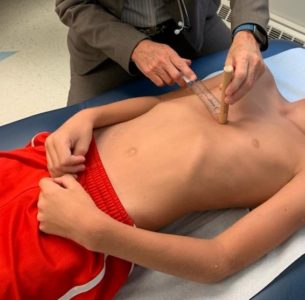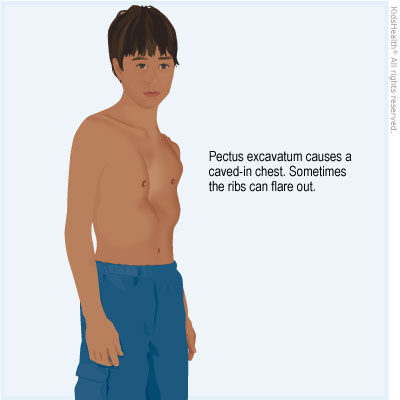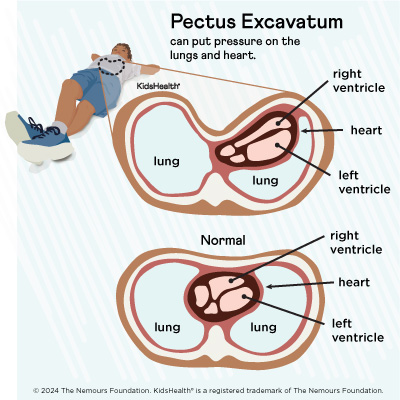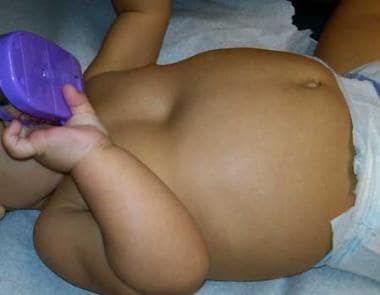pectus excavatum baby symptoms
It occurs mostly in boys and frequently more members in a family are affected. Pectus excavatum is a deformity that makes a childs chest appear sunken or caved in.

Full Shot And Limbs At The Age Of 9 Years A Evidence Of Pectus Download Scientific Diagram
The condition can be mild or severe.

. In pectus excavatum the cartilage is extra long and pushes the. Pectus excavatum PECK-tuss ex-kuh-VAW-tum is a condition that causes a childs chest to look sunken or caved in It happens because of a defect in the tough connective tissue cartilage that holds the bony part of the ribs to the breastbone. This information from Great Ormond Street Hospital GOSH is about pectus excavatum also known as funnel chest.
The condition is not always noticeable at birth but is often apparent by the time a child is 2 to 3. Cartilage is what makes up the outer portion of the ear and lines the joints of the body. Pectus excavatum occurs in approximately 1 out of 4001000 children and is three to five times more common in males than females.
What is a pectus excavatum. The way pectus excavatum affects pregnancy is by a mild form of dyspnea. This may be an isolated abnormality.
It happens when the bone and cartilage connected to our sternum - or breastbone - grow in abnormal ways. An infant with pectus excavatum may have other symptoms and signs that when taken together define. With pectus excavatum the sternum goes inward to.
Your childs symptoms may get worse over time which should be taken into consideration. 1 day agoPectus excavatum is a condition where a persons breastbone is sunken into the chest. This is sometimes called sunken or funnel chest.
Pectus excavatum is a condition in which the breastbone is sunken into the chest. While this can be noted early in life pediatric pectus excavatum often worsens during a growth spurt in adolescence. Pectus excavatum is a condition in which instead of being level with the ribs the breastbone sternum is sunken so that the middle of the chest looks caved in.
1 2 Pectus excavatum may be associated with connective tissue disorders such as Marfan and. The direct translation from Latin is hollowed chest. Pectus excavatum is a chest deformity where the breastbone sternum appears sunken.
This may cause a child concern. But severe pectus excavatum can cause a deep hollow in the chest that can put pressure on the lungs and heart causing. Ad Find information on chronic and acute pain its causes symptoms and recovery period.
The sunken chest can be fixed with surgeries like the Nuss procedure or Ravitch procedure. My child is very active and participates in many sports. Commonly called funnel chest pectus excavatum is a depression caused when the sternum breastbone is abnormally pushed inward.
The cause of pectus excavatum is not known however it can run in families with up to 25 percent of affected patients reporting chest wall abnormalities in other family members. Signs and symptoms can include. Shortness of breath with exercise.
This causes a depression in the chest that can range from mild to severe. Pectus excavatum also called funnel chest is the most common congenital deformity of the front wall of the chest. Pectus excavatum occurs in a baby who is developing in the womb.
Physical symptoms can include. If pectus carinatum is causing symptoms there are two treatment options. It can also develop in a baby after birth.
Pectus excavatum is a congenital deformity of the chest wall that causes several ribs and the breastbone sternum to grow in an inward direction. Due to the pectus patients may have less space in the chest which can limit heart and lung function. Will heshe be able to continue.
Decreased stamina compared to peers. Pectus excavatum is not normally a life-threatening condition. Because of the deep depression the lower ribs can stick out and give the appearance of a potbelly in.
Bracing for pectus carinatum works similar to the way braces work on teeth. This abnormal formation of the rib cage develops during pregnancy and gives the chest a caved-in or sunken appearance. Most common sign is slight indentation in the chestSymptoms that appear due to severe cases of pectus excavatum when the breast bone compresses the lungs or.
Both or just one side of the breastbone may be affected. Fetal brain imaging predicts neurodevelopment of. The cartilage turns to bone as the baby matures.
Find Information on Diseases Conditions Sports Injury Personal Injury. Pectus excavatum is clearly visible as a sunken portion in the center of a childs chest. Usually the ribs and sternum go outward at the front of the chest.
It can also develop in a baby after birth. The child wears the brace for up to 24. The depression in the chest is due to abnormal growth of the cartilage that attaches the sternum to the ribs.
The cartilage pushes the breastbone sternum inward. This is not an emergency surgery so parents and children have time to prepare for the procedure. While most patients do not have symptoms those with severe.
Researchers believe the cause is abnormal growth of the connective tissue that connects the ribs to the breastbone. Her pregnancy was complicated by placenta previa and severe anemia but she delivered a healthy baby. Pectus excavatum also known as concave chest or funnel chest is a deformity of your childs chest wall.
The breastbone or sternum and some of the ribs grow abnormally causing a depression in the middle of the chest. The sternum then grows inward and can even rotate in some cases. The symptoms can be both physical and psychological.
The severity of this condition can range from mild to severe. Pectus excavatum affects about one in. While most patients do not have symptoms those with severe forms of the abnormality may experience.
Pectus excavatum a deformity of the sternum and ribs caused by an unbalanced costochondral hypertrophy is a congenital abnormality with a prevalence of 1 per 1000 patients. Stay in Contact With Your Doctor. The brace is worn around the chest and provides pressure from both the front and back to move the breastbone back to its usual position.
Not all cases need surgery. Shortness of breath with exercise. Pectus excavatum is caused by the abnormal growth in the chest of the connective tissues cartilage that attach the breastbone sternum to the ribs.
The condition is also called sunken. But there is an example of a woman who gets pregnant two years after pectus excavatum repair. Children with mild pectus excavatum often have no other symptoms but more severe cases can affect the heart and lungs.

Pectus Excavatum Lax Abdomen Bilateral Cryptorchidism And Rocker Download Scientific Diagram

Pectus Excavatum Cauze Simptome Tratament Sfaturimedicale Ro

Should I Worry If My Child S Chest Is Sunken Cincinnati Children S Blog

Pectus Excavatum October 2017 Babies Forums What To Expect

Chest Wall Disorder Pectus Excavatum For Parents Primary Children S Hospital
How To Deal With Your Child S Pectus Carinatum Condition Align Clinic

Chest Wall Disorder Pectus Excavatum For Parents Primary Children S Hospital

Pdf Prenatal Diagnosis Of Pectus Excavatum

Pectus Excavatum From A Pediatric Surgeon S Perspective Abstract Europe Pmc

Nuss Procedure For Pectus Excavatum Background Indications Contraindications

Pectus Excavatum Chest Wall Stanford Children S Health

Pectus Excavatum Children S Hospital Of Philadelphia

Patient 2 Note Cafe Au Lait Spots Pectus Excavatum Widespaced Download Scientific Diagram

Pectus Excavatum In Babies Kids 7 Tips For Parents

Pectus Excavatum October 2017 Babies Forums What To Expect

21 Pectus Stock Photos Pictures Royalty Free Images Istock

Help My Baby S Chest Is Caving In Pectus Excavatum Dr Paul Youtube

Newborn Care Chest And Abdomen Philadelphia Fight

A Proband At 3 Years Of Age With Pectus Excavatum Relatively Short Download Scientific Diagram